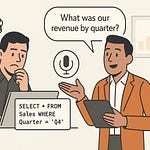Summary
Running Model-Driven Apps: The Unsung Power Platform Hero isn’t about flashy UI — it’s about building secure, stable, production-ready apps that stand the test of change. In this episode, I show you how I take a blank Dataverse table and convert it into a themed, role-aware application with custom forms, views, relationships, security, and automation — live.
We’ll also address the stigma: many dismiss model-driven apps as old and dull, but those who depend on them in enterprise environments know their strength lies in resilience. Once you see how form logic stays tied to the data, how role-based security integrates natively, and how the app adapts when the schema shifts, you’ll understand why “boring” can win the long game.
What You’ll Learn
Why model-driven apps get a reputation for being “boring” — and why that isn’t a flaw
How to build an app from zero: adding fields, relationships, and seeing forms react automatically
How to configure and theme forms, views, and navigation so the app becomes usable and meaningful
How security roles in Dataverse control table, column, and row access — without extra formulas
How the same app can surface differently for different users based on role
How to extend the app: wire in Power Automate, embed Power BI visuals, even hook in AI components
Full Transcript
Everyone loves to clown on Model-Driven Apps: “Old-school!” “Looks like 2008!” “Canvas does this better!” Fine. But here’s the punchline — I’ve built secure, production-ready Model-Driven apps fast, and in this video I’ll show you exactly how. By the end, you’ll see a plain Dataverse table turned into a themed, secure app with custom forms, views, a role, and even an automation — live. Subscribe to the M365.Show newsletter at m365 dot show so you don’t miss the follow-ups.
Model-Driven isn’t supposed to be sexy — it’s supposed to work. Stick around for the 5-minute mark when that “boring” blank table becomes a usable form. And before we get there, let’s address why everyone insists these apps are boring in the first place.
Why Everyone Thinks Model-Driven Apps Are Boring
Model-Driven Apps carry a reputation problem. The common take is that they’re just old, stiff forms with no charm, no flexibility, and about as exciting as Windows XP’s Control Panel. That reputation sticks in kickoff meetings: bring up Canvas Apps and the room perks up; bring up Model-Driven and suddenly everyone needs another coffee. A lot of that comes from people who’ve only ever seen the default, grey starter app. They peek, smirk, and walk away. But judging it from that is like opening Excel, staring at the blank grid, and deciding spreadsheets are pointless—you never even tried the formulas.
The criticism usually circles the same points. The interface looks dated. It’s not as customizable out of the box. Compared to the instant drag-and-drop magic in Canvas, it doesn’t grab attention. And to be fair, if your only exposure is the raw starter template, you’d assume it’s lifeless. Microsoft’s demo culture doesn’t exactly help either: Canvas is all bright colors and custom layouts, while Model-Driven gets positioned as “the serious option nobody shows off.” The flashy one is the cousin doing TikTok dances; Model-Driven is the one who shows up on time with the project plan.
I’ll give you a concrete story. On one rollout I supported, the manager was sold on Canvas. The mock-ups looked slick. It impressed at first. But the moment our Dataverse schema started evolving, things got messy. Every column tweak triggered a handful of fixes across the app—dropdowns broke, formulas needed re-pointing, visibility conditions stopped working. It wasn’t catastrophic, but it was constant patching. Meanwhile, the Model-Driven build we had sitting quietly in parallel kept pace with the schema changes because the form logic was already sitting where it belonged—in Dataverse. No scrambling, no rework, just steady updates. That “boring” Honda Civic app ran quietly while the sports car prototype was in the shop.
This stability isn’t about luck. In practice, when we use Model-Driven builds, the core business logic lives directly in Dataverse rather than being stretched over connectors and side scripts. That means when the schema shifts, the platform adjusts without a lot of duct tape. I’ve seen the difference firsthand. And to avoid staying too theoretical, we’ll actually attach a security role and wire up a relationship live in this demo so you can see how it behaves, not just hear me say it.
Another piece the critics miss is security. In many Canvas builds, you end up writing conditions or duplicating checks in a few flows. In contrast, Model-Driven apps tie straight into Microsoft’s role-based model. In my experience, if an auditor or finance manager needs a clean division of what they can view versus what they can edit, roles handle it without me reinventing the wheel. It doesn’t look flashy, but it scales without panic. And that’s exactly why enterprise environments lean on it.
Bottom line: Model-Driven isn’t trying to win design awards. It’s designed to get you to production without constant fires. People can call it dull, but dull and stable beats pretty and fragile when the business depends on it. Sure, it may not sparkle in the first five minutes, but once you push it, you start to understand the long game advantage.
That’s what we’re going to put to the test. Instead of telling you it works better at scale, we’ll start from the absolute bare minimum and build forward in real time. From a single empty table, we’ll see how quickly structure, relationships, and even basic security can fall into place. And the best part is, you’ll watch the change happen right on screen.
Building from Zero: The 'Before' State
You open Dataverse and there’s one empty table. That’s where a lot of folks check out and dismiss Model-Driven apps. Nothing greets you—no dashboards, no forms, no quick sparkle of progress. Just a bare table with no personality. It looks like someone abandoned the setup wizard halfway, and for skeptics, that’s proof enough it’s boring. But really, this is just the launchpad.
The truth is, on its own, that empty table does look lifeless. If you’ve been hanging around Canvas, you’re spoiled by the quick dopamine: drag a box, add a dropdown, and instantly it feels like something alive. Model-Driven doesn’t hand you that upfront rush. Instead, it’s designed around structure and stability. It asks: do you want something that looks busy right away, or something that’s going to hold together when business requirements shift six months from now?
So let’s treat this plain starting point like a demo roadmap. Step one: add a few fields. Step two: create a relationship so tables can talk to each other. Step three: see how that instantly shapes the form without custom code. That’s enough to flip it from dead weight into a working scaffold you can keep building on.
Fields are where we begin. You don’t need code, scripts, or PowerShell here. In the table designer, you drop in a text column for a name, maybe a choice column for status, maybe a lookup to another table. It’s straightforward, and the change is baked into Dataverse itself. I’ve built enough apps to know—when you define a column here, it’s consistent everywhere. You won’t be chasing 15 different dropdowns across the UI later. We’ll actually add those live in a second so you can see how quickly the form reacts.
Think of it as snapping Lego bricks onto a base plate: every new field adds a piece, ready to link with the next. You can rearrange pieces without wrecking the foundation. Contrast that with Canvas, where sometimes it feels like pouring wet concrete—once it sets, you’re stuck with it unless you want to start over. The Lego model keeps things flexible without cracking the base.
Now we add a relationship. Imagine linking Customers to Orders. In Dataverse, once you define that connection, the platform already knows how to behave. Relationships are treated as first-class citizens. You’re not patching formulas or fighting delegation rules. The moment you add the lookup, it flows through the app. When we set this up in the demo, watch how related records simply appear in the form—there’s your micro‑payoff. That’s the kind of instant feedback most people assume doesn’t happen in Model‑Driven apps.
At this stage, it’s no longer an empty shell. You start to see the skeleton of a real business app: one table branching into another, roles you could imagine plugging in, and forms that are already becoming functional. Suddenly, it’s obvious how sales could log interactions, finance could track invoices, or managers could pull reports. Five minutes ago we had a blank placeholder; now, there’s scaffolding you can actually use.
And here’s the important part that critics miss: this structure comes together without hacks or backflips. You don’t need to duct-tape flows or rewrite formulas just because a schema changed. The system is working with you instead of against you. It’s not about speed bragging rights. It’s about how reliably and cleanly the foundation grows once you start adding parts.
So by the time we close out this “before” state, we’ve already gone from one lonely table to a connected framework with fields, choices, and relationships in place. When you see the first form render those related records, you realize the platform isn’t stuck in neutral. It’s already moving forward.
Next, we go from skeleton to presentation. Because what everyone loves to complain about is how it looks. And that’s exactly where we’re headed.
From Skeleton to App: Form, Views, and Theming
When critics call Model-Driven Apps “stuck in 2008,” they’re really talking about the default look. Spin one up and you’re met with a grey interface that feels like corporate beige wall paint—functional, but forgettable. That plain start is intentional: it’s not trying to wow anyone out of the box, it’s giving you a blank workspace. Instead of dwelling on the blandness, we’ll walk through three quick moves that take the skeleton into something that feels like an actual app—forms, views, and theming.
Step one is restructuring the form. Out of the box, every field gets dumped into one long column, like someone unloading all their groceries down the checkout belt with no order. Navigating that isn’t fun for your users, and it doesn’t help anyone make sense of the data. In the form designer, we can break that mess into logical sections: customer info on the left, order details on the right, and a new tab holding notes and history. Watch here as I move the contact block into a clean tab—notice how the record still renders properly and the relationships remain intact. Same data model underneath, just organized in a way that humans can actually use. Think of it like tailoring a suit off the rack; the material is the same, but once it’s adjusted, it looks and works ten times better.
Step two is building out the views. The default view is a flat list that could make even the most caffeinated project manager glaze over. But we can create perspectives that match the needs of different roles. For managers, a summary view highlights high-level counts, open cases, or status fields so they can track progress at a glance. Analysts, on the other hand, want the detailed view—the ability to drill into every record without extra clicks. In my experience, this takes just a few tweaks in the view builder. Watch here as I define a new manager view and toggle between it and the analyst view—you’ll see how the app automatically shifts to give each group the slice of data they care about. There’s no need to build a separate screen for every role; one table view setup gets you multiple user experiences.
Step three is theming and navigation. This is the fastest way to shed the “generic Microsoft” feel. A quick update of the header color, the primary button highlights, and dropping in your company logo can shift executive perception faster than you’d expect. A minute of theming reduces VP demo snark and increases trust. While we’re at it, we also trim the navigation bar, exposing only what matters to each group. Sales sees leads and opportunities, Finance sees invoices, and nobody has to wade through tables irrelevant to their day-to-day. Watch as I hide a few tables from our navigation and reorder the menu—you’ll notice right away that the app already feels intentional, rather than like a half-finished prototype.
The important thing here is what stays consistent behind the scenes. In my experience, when we rearrange form layouts or adjust views, the underlying data model in Dataverse isn’t destabilized. We’ll show this directly as I shuffle a section—data stays where it should, relationships continue working, and there’s no cascade of fixes required afterward. That’s a very different reality from some Canvas builds, where moving fields or re-pointing visibility can ripple into unexpected errors. When you see these changes applied right in the designer and the app just adapts, it underlines the quiet strength of the platform.
By this point the app looks less like a fossil and more like a tool worth actually deploying. It’s still not going to headline a design magazine, but it no longer feels like something you’d be embarrassed to show in a project demo. Instead, it shows the basics: organized forms, functional views, and enough brand identity that people recognize it belongs to them. That’s often all your users actually need in order to take it seriously.
Now, appearance is a good start, but it only goes so far. Because here’s the catch: none of this matters if the wrong employees can stumble across the wrong data. That’s the make-or-break detail that separates a prototype from something ready for enterprise. So the next move isn’t about polish—it’s about control. If a new intern can pull up payroll records, you’ve already lost. And that’s exactly what we need to fix next.
Subscribe at m365 dot show or follow the M365.Show page for live sessions with MVPs walking through these setups. Because the next chapter addresses the real differentiator—who can see what, and why security is the feature that actually sets Model-Driven Apps apart.
The Secret Weapon: Security at Enterprise Scale
Who cares about buttons and color palettes if the Accounting intern can stumble into payroll? That’s the weak spot that separates a demo toy from a production app: security. And in Model-Driven Apps, this isn’t patched on later. It comes from Dataverse itself, which is why enterprises keep leaning on it.
From what I’ve seen in Canvas builds, you often end up stitching checks across multiple layers. A filter in the gallery. Conditions in the formula bar. Maybe another one in a flow. It works—until the schema shifts and suddenly five screens need edits. Miss one, and you’ve just gifted Sales with HR’s paycheck data. In this demo, we’ll contrast that with a Dataverse-backed model so you can see for yourself how it behaves differently.
Here’s the plan. First, I’ll create a Sales role and restrict it to Opportunities. Then, I’ll create a Finance role with access only to Invoices. Finally, we’ll log in as each role and see how the app surfaces a very different picture. Same app, same data source, but two users logging in get two completely different scopes of visibility. No extra formulas, no duplicate screens. That’s the payoff: you define once, and it’s respected everywhere.
Think of roles like keychains. Some people get a master set with access to the whole building. Others only get the side door and a spare key to one room. If you test this live as we’ll do here, you see immediately how one login surfaces fewer tables, fewer columns, and fewer records. It’s not abstract—it’s tangible in the UI.
And it’s not just table-level. We’ll also show how to clamp down further. For example, Finance can see invoices but not edit customer contact info. Or Sales can view Orders but not change invoice amounts. The same model lets you restrict at the field level. You’ll watch one login display a column that quietly disappears for another. That’s the kind of moment where people realize controls are baked into the data layer instead of duct-taped into the interface.
Scaling this is where things usually break in other approaches. In Model-Driven, because roles tie back to Dataverse and Azure AD groups, you can map permissions once at the group level. Add or remove users from a group, and their app access flips automatically. Ten users or ten thousand—the framework doesn’t ask you to replicate formula conditions screen by screen. This simplicity is why many admins reach for it when things get serious.
Pro tip here: when you’re rolling out roles, don’t launch straight to production. Create a pilot user or two, drop them into the Sales role, and click around in the app as if you’re wearing their badge. You’ll catch mistakes fast—better to find out your test account still sees payroll than to have an employee call you with that problem later. Once you iron it out, then expand to the larger group.
When you manage security this way, you’re not reinventing the wheel every quarter. Instead of retrofitting rules in flows, you’ve already got the foundation set at the source. And in my experience, that’s the part the critics never see—because they stop at “the UI is boring” long before they log in with different roles and realize two users can’t even see the same universe of data.
So, the takeaway? Model-Driven Apps shift the burden from you micromanaging conditions to the platform handling them. You focus on structure; Dataverse enforces the boundaries. It’s consistent, testable, and easy to adjust when the org chart inevitably changes. Update a role once, and you’re done.
Now, security alone doesn’t make an app shine. It keeps it safe, sure, but once the foundation is solid, the obvious question follows: how do we actually make it smarter and more connected? That’s where things get interesting.
Subscribe at m365 dot show for the newsletter, or follow the M365.Show page for livestreams with MVPs. In the next part, we’ll build on this secure core and show what happens when you start adding Power Platform components on top.
The 'After': Extending with Power Platform Components
Here’s where things get interesting: once the structure and security are solid, the real payoff is extending the app with Power Platform components. This is the “after” picture most skeptics never get to see. A Model-Driven App isn’t just a stack of forms and views; it’s the launch pad where automation, analytics, and even AI start to layer in. Think of it less like a bland 2008 database shell and more like a control panel that wakes up once you connect the rest of the system.
Automation demo: Power Automate is the first extension that makes jaws drop. We’ll wire up a flow that triggers when a new record is created. The micro‑payoff? You’ll watch a new customer record instantly kick off an email and a Teams notification without any extra coding. The moment it runs, you see the background humming: the manager gets pinged, the record is logged, and nobody has to sit on the refresh button to figure out what’s new. That’s “flexibility” in practice—quiet systems work that frees your people from babysitting the data.
Analytics demo: next is Power BI right inside the app. Rather than asking users to bounce out to another tab or bookmark, we’ll surface a simple report on a main form. The immediate payoff? While working on a case, you’ll see live totals and trend lines without leaving the screen. No “where’s the report link again?” moments, no retraining, no side adventures in another URL. The data follows their workflow. And because we’ll show it live, you’ll watch the chart render while switching records—so you know it’s not a screenshot pinned to a wall.
AI demo: for a glimpse of what’s next, we’ll use Copilot components or AI Builder. Here’s the micro‑win: while composing a note on a record, we’ll test AI‑suggested text and show how it injects context from prior history. When you see it offer a draft response or a suggested follow‑up task directly in the form, that’s the moment it clicks that this platform isn’t static. And here’s the kicker: because it all runs in Dataverse, the same role logic applies. The intern account won’t suddenly get AI‑summarized payroll data they shouldn’t even touch.
Now, quick caution. When you plug in automation or AI, don’t assume governance takes care of itself. The system respects security, but only if you design the flow or notification properly. If you route all approval emails to a shared inbox by accident, guess what—you just leaked data through your “clever” automation. Pro tip: test with a scoped role first, confirm that restricted users only get what they should, and then expand. Otherwise, your clean security model just got bypassed by a trigger-happy flow.
Viewed together, these pieces—automation, analytics, and AI—turn Model-Driven Apps into more than static shells. The Lego analogy fits: the app is the base plate, and each Power Platform piece snaps on cleanly. You’re not reinforcing a wobbly shed; you’re stacking modules on a solid foundation. That’s why, when people watch the micro-demos, the penny drops that this isn’t “boring IT plumbing.” It’s a framework that scales with real business pressure.
By now, the picture has shifted: we started with that one lonely table, then built the skeleton with fields and relationships, layered forms and views for humans to actually use, locked it down with security, and now extended it until it runs like a proper hub. That’s the real “after” shot—an environment that integrates process, data, and intelligence without you duct‑taping five tools together.
And if you want to catch the full AI demo where we test Copilot suggesting follow‑ups on a record, stay tuned for the last minute. Seeing that happen live lands harder than any marketing slide.
So at this point, the question isn’t about whether these apps look dated. It’s about whether you want to get business done in a way that scales without constant patch jobs. That’s the perspective we’ll carry forward.
Conclusion
Model-Driven Apps are boring by design—and that’s exactly why they work in production. In today’s demo you saw the proof: we took a lonely table, shaped forms, built focused views, locked it down with roles, and even triggered an automation—all without duct tape. Reliable may not grab attention, but it keeps the lights on.
If this helped you dodge two hours of debugging in your head, hit subscribe right now. Follow the M365.Show on LinkedIn for livestreams with MVPs who’ve run these apps in the wild. And subscribe to the M365.Show Podcast for more blunt survival guides.
Your turn: tell us in the comments—what’s the biggest pain you’ve hit when a schema change breaks an app?











